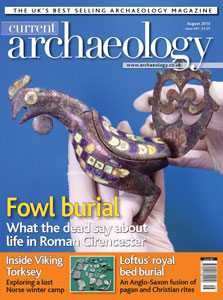Tracking the movement of ancient armies is notoriously difficult. On those occasions when a mobile force threw up a bank and ditch for temporary shelter traces of the defences may survive. Otherwise, detection is dependent on vague clues in any written records and tantalising finds scatters in otherwise innocuous fields. This was the challenge facing scholars on the trail of the micel here, a Viking army that terrorised England for over a decade. Known to have overwintered in Lincolnshire, metal detector finds pointed to an area of high ground beside the River Trent. Now fresh survey and excavation is revealing how these Norse warriors whiled away the winter months.
Excavations in an Iron Age enclosure at Street House unexpectedly revealed an Anglo-Saxon cemetery. As well as showing how the prehistoric earthwork influenced the later burial rites, the Anglo-Saxon interments provide a glimpse of how new and old traditions entwined as England converted to Christianity. Was a princess who played a key role in this transition among the Street House cemetery dead?
More unexpected burials were discovered in 2011 outside the walls of Roman Cirencester. On this occasion the presence of a cemetery had been known for over a century, but it was believed that any archaeology had been destroyed during 1960s construction. Modern investigation has provided our clearest glimpse of the town’s Roman burials for 40 years, and even shed light on an enduring mystery about the road network.
Finally, the Roman conquest provided another key transition period. Excavations in an Iron Age banjo enclosure are highlighting how the traditions of the local tribe robustly withstood the initial shock of imperial oppression. Despite witnessing their land being carved up by their new masters, recent research suggests that the locals weathered the Roman storm, reasserting their influence once Roman Britain disintegrated.
FEATURES/n
/n
VIKING TORKSEY/n
Inside the Great Army’s winter camp
Recently relocated by an interdisciplinary research project, what can this site tell us about Viking pastimes, Medieval loot-processing, and the birth of Saxon burh?
BURIED IN A ROYAL BED/n
Street House Anglo-Saxon cemetery
With the surprise discovery of over 100 Early Medieval graves on a site thought to contain only Iron Age remains, we explore a story of elite burials, Christian conversion, and Loftus’ royal connections.
CORINIUM’S DEAD/n
Excavating the Tetbury Road Roman cemetery
After an everyday watching brief revealed the unexpected survival of pockets of Cirencester’s Roman burial ground, what can new research reveal about the city’s ancient inhabitants?
DIGGING THE DUROTRIGES/n
Life and death in late Iron Age Dorset
Ongoing excavations at a prehistoric ‘banjo enclosure’ have rewritten understanding of tribal life in Dorset before and after the Roman Conquest.
NEWS/n
Saxons in the Stonehenge landscape; Unpicking potted prehistory; Second henge for Kent; Dornier-17 rises; Conserving the Must Farm boats; Segontium’s ovens: food for fort?; Kent’s distant ancestors
REGULARS/n
Context
Let’s go fly a kite: Clettraval, North Uist
Reviews
Prehistoric materialities; The Romano-British peasant; Disease in London, 1st-19th centuries
Festival of British Archaeology
Highlights from this year’s nationwide celebration of heritage events
Sherds
Chris Catling’s irreverent take on heritage issues
Odd Socs
The Manorial Society of Great Britain

